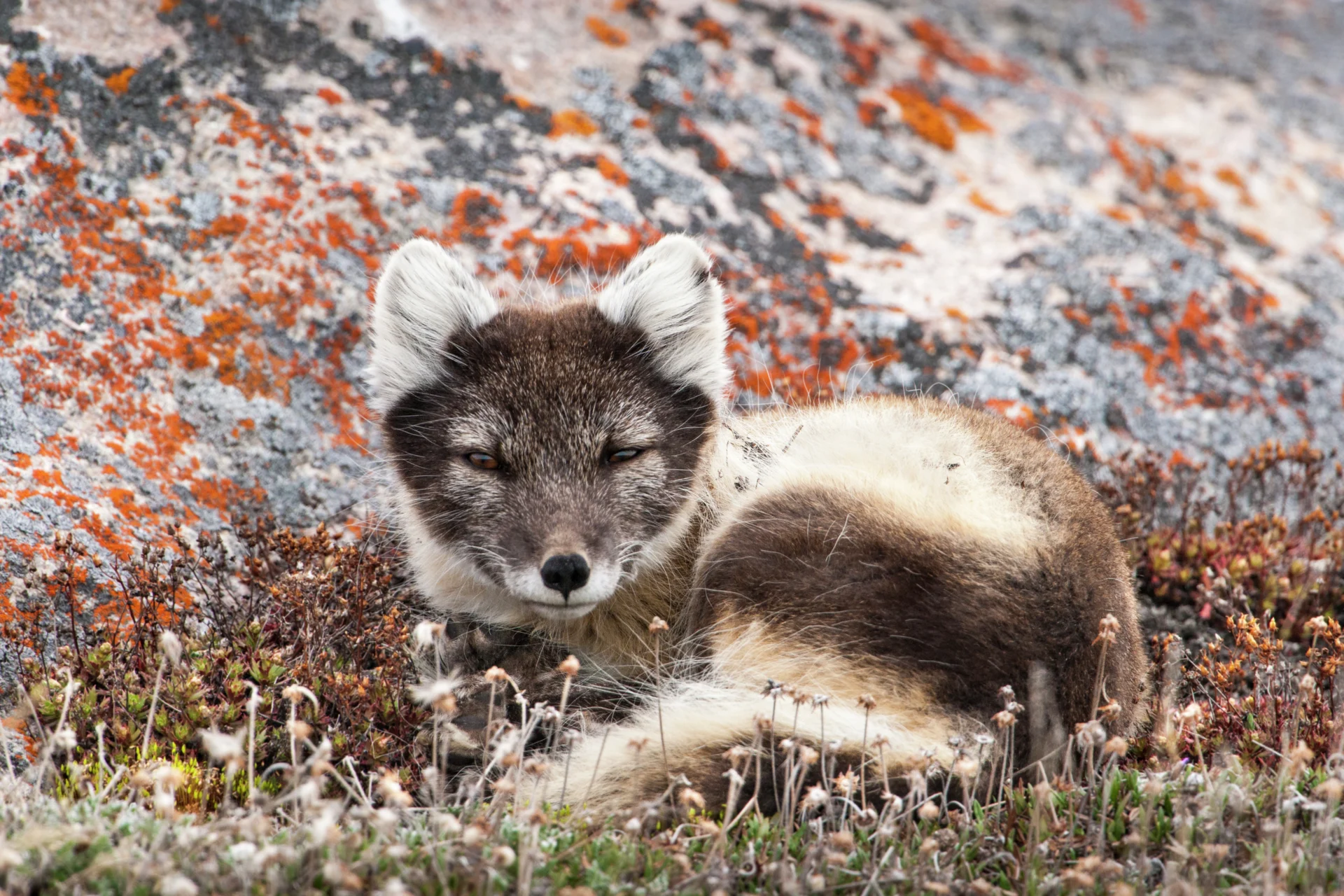Nordvästpassagens djurliv
Nordvästpassagen är ett orört högarktisk område. Regionens myskoxar, vildrenar, sälar och isbjörnar förflyttar sig till varmare breddgrader eller anpassar sig till det istäckta landskapet.
4 minuters läsning
Långväga släktingar
Arktis är hemvist för sex sälarter: grönlandssäl, klappmyts, vikare, storsäl, largasäl och bandsäl. Dessa häpnadsväckande däggdjur håller värmen med ett tjockt lager av späck och päls, vilket gör att de kan jaga föda på upp till 2 000 meters djup och hålla andan i upp till två timmar.
Valrossen, som kan väga upp till två ton, är det största djuret i sälfamiljen. Dessa köttätare saknar den päls som andra sälar har och förlitar sig istället på sitt späck och sin förmåga att sänka pulsen för att klara sig i det iskalla vattnet. Valrossarna är sociala djur som oftast syns i stora klungor på isen.
Beundransvärda betar
Det vetenskapliga namnet för valrossar är Odobenus rosmarus, latin för ”tandgående sjöhäst”. Ett passande namn på ett djur vars betar faktiskt är tänder och som kan bli över 90 centimeter långa! Betarna, som aldrig slutar växa, är störst hos hanarna. Valrossen använder sina betar för att ta sig upp på isflak eller för att försvara sitt territorium.
Regionens rovdjur
Vikare och storsälar är de naturliga bytesdjuren för isbjörnar på Nordpolen. Med sin kritvita päls och en höjd på upp till tre meter stående är dessa ensamlevande björnar en imponerande syn. För att få syn på en isbjörn i det snötäckta landskapet kan du behöva titta noga! Isbjörnar föds i djupa snöhålor på land men tillbringar merparten av sina liv på havsisen där de finner sin föda i vattnet. Därför är isbjörnen den enda björnarten som anses vara ett marint däggdjur. Om du har tur kan du få en glimt av det sällsynta djuret längs strandlinjen.
En värmande osynlighetsdräkt
Under den vita pälsen är isbjörnens hud kolsvart, vilket hjälper den att behålla den solvärme som har absorberats genom pälsen. Pälsen saknar vita pigment och består istället av ihåliga hårstrån som sprider ljus, vilket håller isbjörnarna kamouflerade ute på havsisen. Ett tätt lager av underpäls och späck isolerar kroppen och håller isbjörnen varm.
Sommargrannar
Det kanske är svårt att tänka sig att växtätare skulle trivas på en plats med så mycket snö. Under sommarmånaderna kan du dock se flockar av myskoxar och vildrenar livnära sig på tundrans gräs och växter. När temperaturen sjunker och snöfallet ökar går de skilda vägar. Vildrenarna tar sig söderut till ett mer skyddat klimat medan myskoxarna stannar kvar.
Om du ser en flock med vildrenar, lägg märke till att både deras mular och hovar är pälstäckta. Pälsen under hovarna hjälper dem att gå på isen medan håret kring mulen värmer upp den kalla luften på väg ner i lungorna. Myskoxen är kanske mest känd för sin lurviga päls, men det är den starka doft som hanarna avger under parningstiden som gett djuret dess namn.
Återbildande horn
Vad som skiljer en vildren från andra renar är att både hanarna och honorna har horn. Till en början är hornen täckta av ett lager av ludd som kallas sammet. Detta ger näring till hornen och hjälper dem att växa. När de har vuxit färdigt fäller djuret sammeten för att avtäcka vassa, rödtonade horn. Kort därefter faller även dessa horn av och växer ut på nytt under nästa år.
En mästare på kamouflage
Den 60 centimeter höga polarharen har en unik förmåga: den kan ändra färg på sin päls. Under vintern är det lätt att missta haren för en stor snöboll. På sommaren får pälsen istället en blågrå ton som smälter in bland regionens stenar och vegetation. Förmågan att ändra färg och kunna springa i upp till 65 km/h är ett måste för att undvika dess största fiende, fjällräven.
Sommaren är dock så kort i de områden vi besöker i Nordvästpassagen att polarhararna som lever här sällan behöver ändra sin färg från vit.
